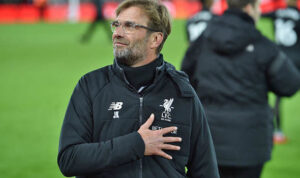Liverpool vs. Arsenal: A Tactical Breakdown
A sign of Liverpool’s transformation under Jürgen Klopp is that their home games against Arsenal are now judged not by whether they win, but by how many goals they put will past the Gunners.
A sign of Liverpool’s transformation under Jürgen Klopp is that their home games against Arsenal are now judged not by whether they win, but by how many goals they put will past the Gunners.
Recent meetings have been brutally one-sided, and with Liverpool now enjoying the swagger of being European champions, Arsenal could have been forgiven for fearing the worst.
Instead this was one of the more tactically fascinating encounters.
Liverpool did eventually pull away as comfortable winners, but were troubled for periods of the first-half, unsettled by Arsenal’s pace on the break. There was evidence to suggest that Unai Emery is continuing to resurrect Arsenal, but the alarming gap in quality between the two sides has shown the amount of work yet left to do.
This was not the best Liverpool performance, but in patches they stormed through the gears and sliced Arsenal open.
It could have been different during the first-half when Arsenal probed on the break, but in the end, they were well beaten.
Arsenal sat deep with a diamond and gave up the flanks to Liverpool
Playing out from the back carries both its rewards and risks, particularly against a high, ferociously pressing team like Liverpool.
The Reds tend to press together, their players converging as one single organism. If the high press is bypassed, teams are in good positions to hurt Liverpool. But during the opening ten minutes, the visitors were trapped in their own half, prisoners of their own conservative approach and overrun by the frenetic pressing with which Liverpool excel.
There is some resilience to this Arsenal team, and the diamond midfield allowed them – in theory, at least – to outnumber Liverpool’s midfield. Though Liverpool’s forward line often drop deep, it also allowed them to squeeze out any space centrally. Liverpool pushed Arsenal back but found a wall of eight players shepherding them away from clear-cut goal scoring chances. It was strange to see an Arsenal team defending close to the edge of their box with, though the recent capitulations at Anfield had obliged a more defensive approach.
Willock in particular impressed, he was tenacious and shimmering with energy, unfazed by a midfield capable of overrunning teams in moments of attacking frenzy. Arsenal’s narrow shape meant they were not overwhelmed centrally and forced Liverpool to be more patient. It also meant that the space with which the Reds like to operate did not exist in the middle of the park, as Arsenal were happy to sit deep, secure in their numbers.
Although this helped, at times, in disabling Jordan Henderson’s forward surges – which have been effective in creating space for Mo Salah to come in from the wings – Arsenal surrendered the flanks to Andy Robertson and Trent Alexander-Arnold. Their fullbacks were pinned back, unable to advance and support their own forward line.
Liverpool were able to continuously attack the flanks, and were able to double or triple up on Arsenal’s fullbacks, and find time and space for crosses. This was a risky ploy. The tactic could easily have backfired had Liverpool’s fullbacks been more precise with their crossing. The effects of this during the game will be discussed a little later.
Pépé’s pace troubled Liverpool – briefly
Much had been made about how Pépé would fare against Liverpool. The winger was fearlessly direct, troubling Liverpool with his speed.
Nicolas Pépé vs. Liverpool
91% Pass accuracy
1 Key pass
2/4 Shots on target
7/10 Dribbles completed
1/2 Tackles wonProbably Arsenal’s best player today. There are promising signs, he looked very lively, involved and often dangerous. pic.twitter.com/DVj4ZL6pj6
— The Tactical Times (@Tactical_Times) August 24, 2019
Arsenal had their two attackers up front directly against Matip and van Dijk, with Robertson and Alexander-Arnold regularly streaming forward and vacating space.
This asserted a tense tactical dimension to the game where Arsenal were taking risks in ceding the flanks, but Liverpool were reliant on their pressure – and Arsenal mistakes – to win turnovers.
There were numerous moments during the first half when Arsenal threatened on the break, most notable when Pépé capitalised on a Henderson mistake and left Robertson trailing with quick feet, though he finished weakly.
Pépé’s raw pace, direct running and ability to unsettle will bode well for his future at Arsenal.
The problem for Arsenal was the strength of the Liverpool defence. A defensive unit capable of marshalling their lines superbly and demoralising opponents with clever traps, fantastic reading of the game, and simple, brutal strength.
Much has been made about of the way Pépé got a toe to the ball and raced past Van Dijk, but the Dutchman caught up to him within seconds to restrain his advance long enough for a clutch of supporting players to surround Pépé and force a turnover.
Similarly, Wijnaldum dispossessed the winger in a dangerous wide area, and displayed typical press resistance to calmly clear the ball.
Liverpool defend as a collective and are not fazed by individual pace or skill.
The central pairing of van Dijk and Matip outclassed Barcelona’s front-line during their legendary win at Anfield in May. Once they adjusted to the speed of their opponents, Arsenal simply didn’t have enough attacking options to seriously challenge Liverpool. Their clearest chances came from errors made by Adrian and Jordan Henderson, rather than through their own passages of play.
This was owing to their system, a system which lacked width, demanded too much of their fullbacks, and wasn’t built to create in midfield but to simply prevent.
Liverpool’s pressing and flank play overwhelmed a tired Arsenal side
There are three main ways to attack a team from deep. Pass your way out of the back, play long to a holding striker, or aim for runners in wide areas. The problem for Liverpool, prior to van Dijk, was that teams could bypass their high press with a long ball. That is now very difficult. Often, the only option of maintaining through defensive to offensive transitions is through controlled short passing and playing out from the back.
Arsenal tried this and fell into trouble a number of times. A slack Ceballos pass across his own 18 yard box was collected by Mané 15 yards from goal, though the shot was well saved. The visitors were never comfortable with Liverpool’s high pressing. They found themselves trapped during the opening minutes of the game, and then overrun in the second half.
This style is perfectly suited for a big game with the closed, intense and raucous atmosphere generated at Anfield. Liverpool didn’t blow Arsenal away but there were moments when their pressing threatened to do so.The coordinated, methodical ball-hunting pressure built by years of effort and practice, is something Liverpool are now masters of. It allowed them to continually regain possession and prevent the visitors from enjoying enough time on the ball to do anything meaningful with it.
Another factor behind the one-sided nature of the second half is that Arsenal were were facing exhaustion.
There were moments during the first half when they had eight players defending in their own box. Liverpool had been probing relentlessly, and even if a meaningful chance had not yet materialised, the pressure would have drained Arsenal physically and mentally. Constantly switching flanks, holding onto possession, forcing players to track and chase sideways eventually takes it toll.
The visitors were slower to press and close down during the second half. Liverpool were physically indomitable, simply going up another gear where Arsenal looked weary and heavy-legged. It was a testament to their character that they summoned the energy for a consolation goal.
Firmino dazzles with his selfless interplay
The UEFA Super Cup win over Chelsea illustrated the importance of Roberto Firmino in how Liverpool play.
His intelligence and movement allows Salah and Mané to fill vacant space, his link-up play is superbly selfless. The effort and heart he displays makes him the orchestrator of Liverpool’s gegenpress. Against Arsenal, he dropped into space between their defence and midfield, moving across the pitch, linking up with Mané and Salah to create flank overloads and confuse Arsenal’s defence. The fluidity of movement between Liverpool’s attacking trident was just too much for Arsenal, particularly during the second half when more space appeared.
There was no real midfield support adequate enough to stop him. Granit Xhaka needed someone like Torreira beside him to stem the attacking tide. Firmino simply continued to occupy dangerous positions and find space. For Liverpool he is everything – attacker, creator and defender.
Worthy winners
Arsenal defended relatively well but were set-up to avoid conceding. Once they did, they didn’t quite know how to respond. Liverpool were, at times, unsettled by the Gunners but were ultimately always in control of the game.
9/9 points for Liverpool and they extend their league winning streak to 12 games.
They were ruthless, relentless and effective. They didn’t need to work too hard for the win.
Another goal conceded will annoy Klopp, but they kept a very good team very quiet today.
— The Tactical Times (@Tactical_Times) August 24, 2019
Rabbil Sikdar is a Freelance Writer and a huge Liverpool fan who writes about his main interests, football and politics. You can find Rabbil on Twitter.
If you liked this, or any of the content we provide at The Tactical Times, please consider donating towards the upkeep and continued operation of the site.
[asp_product id=”549″]


